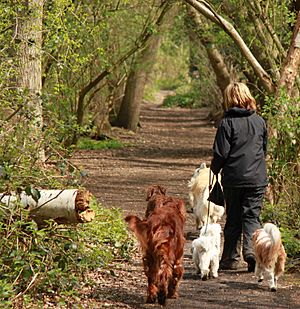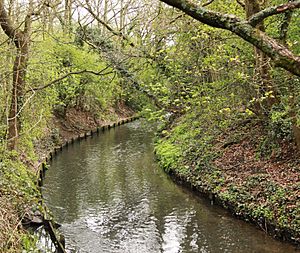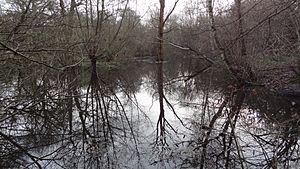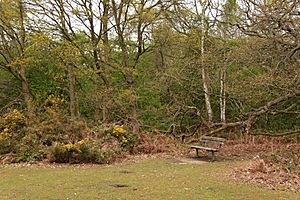Fishpond Wood and Beverley Meads facts for kids
Fishpond Wood and Beverley Meads is a special natural area in London, right next to Wimbledon Common. It's a local nature reserve, which means it's a protected place for plants and animals. This reserve is about 5.8 hectares big, which is like 14 football fields! It's looked after by Merton Council.
Contents
A Journey Through Time
Long, long ago, in the Middle Ages (around 800 years ago!), the area called Beverley Meads belonged to a place called Merton Abbey. People think the two ponds in Fishpond Wood were made around that time. There was probably a watermill at Mill Corner, near the Beverley Brook stream. This mill was used for "fulling," which is a way of cleaning and thickening wool. Sadly, it's thought the mill burned down during the Tudor period (about 500 years ago).
After the mill was gone, more trees started to grow around the ponds. For a long time, even after the abbey closed down in 1538, the land was used for farming. It was part of Warren Farm until shortly after World War II (around the 1950s).
The ponds themselves are a bit of a mystery! Even though they might have been linked to the old watermill, they only started appearing on maps in the early 1800s. Maybe they weren't considered important enough to draw on older maps.
In the 1950s, the land was bought by Wimbledon Council so people could enjoy it. The old medieval ponds were even drained. Later, in the 1970s, the area was turned into a "pitch and putt" golf course. This brought in new soil and really harmed the natural grassland. The golf course was eventually closed in 1981.
But good news! In the 1980s, people started to fix up the area. One of the ponds was cleaned in 1989, and its broken edges were fixed in 1992. Now, it holds water for most of the year. In 1993, Fishpond Wood and Beverley Meads officially became a local nature reserve, a safe home for wildlife.
Exploring Nature
Discover Fishpond Wood
Fishpond Wood is next to Warren Farm. It has wet areas surrounded by old oak and hazel trees. Some of the hazel trees are being managed by "coppicing" again. This is an old way of cutting trees down to the base so they grow back with many new stems. It helps keep the woodland healthy. However, it's harder for new trees to grow now, possibly because there are more rabbits and muntjac deer (small deer) around.
The ponds are home to many amphibians like frogs (sometimes thousands!), toads, and newts. In summer, you can also see beautiful dragonflies and damselflies flying around.
Many other animals live in the wood too! You might find wood mice, different kinds of voles, and shrews (tiny, mouse-like animals). There are also weasels, foxes, rabbits, and grey squirrels. Sometimes, you might even spot pipistrelle bats flying at dusk.
Bird watchers will love it here! You can see different kinds of woodpeckers like the lesser spotted, greater spotted, and green ones. Look out for tree-creepers climbing up tree trunks and redwings visiting in winter. Mallards, moorhens, and sometimes even mandarin ducks have raised their young nearby.
What You'll Find in Beverley Meads
Before World War II, Beverley Meads was used for grazing animals. Now, the four meadows (or "meads") are mostly overgrown with bushes. But some parts still have "acid grassland," which is a very rare type of habitat in London. It's super important for wildlife, especially for grassland butterflies. People are working hard to clear back the bushes to help this special grassland grow back.
If you're lucky, you might see butterflies like large, Essex, and small skippers. Also look for small coppers, common blues, commas, meadow browns, and small heaths.
Just like in the wood, there are many different birds in the meads. You might spot green woodpeckers, different kinds of tits like blue, great, and long-tailed tits. Keep an eye out for blackcaps and bullfinchs too!
You can get to Fishpond Wood and Beverley Meads by walking from Wimbledon Common. There are also footpaths from Barham Road (past the rugby club) and from Robin Hood Way, across from Coombe Hill Road.





